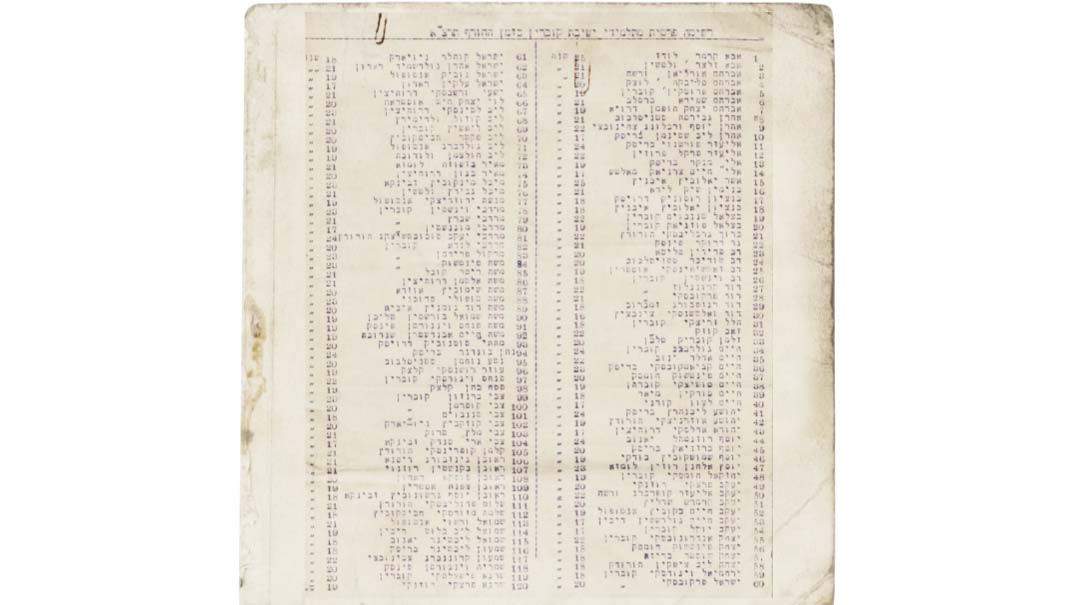Raising Rav Aharon Leib
| November 23, 2021With Rav Pruskin’s appointment as rabbi of the town in 1924, the yeshivah began to enjoy the support of the local population and subsequently grew in numbers and prestige

Title: Raising Rav Aharon Leib
Location: Kobryn, Poland
Document: Kobryn Yeshivah Roster
Time: 1931
The shtetl of Kobryn in the Brisk district enjoyed a rich Jewish history. In the mid-19th century it was the center of Lithuanian chassidus, with the establishment of the court of Rav Moshe Polier of Kobryn. A student of Rav Mordechai and Rav Noach of Lechovich (Lachowicze), his primary chassid Rav Avraham Weinberg founded the Slonim dynasty, while his own descendants continued the Kobryn dynasty.
In 1879 Rav Pesach Pruskin, a descendant of Rav Moshe of Kobryn, was born in the vicinity of the town. After studying in Radin under the Chofetz Chaim, he proceeded to Slabodka, where he was selected by Rav Nosson Tzvi Finkel, the Alter of Slabodka, to be one of the 14 Yad Hachazakah founders of the yeshivah in Slutzk. He eventually was hired as the mashgiach in Slutzk, and left in 1908 for Shklov, where he founded his own yeshivah. One of the talmidim who followed him to Shklov was a young Rav Moshe Feinstein.
In 1911, Rav Pesach was appointed rabbi of Amstzislav (Mstislavl), and the yeshivah moved with him. This was one of the only yeshivos that remained stable in its home surroundings throughout the upheavals of World War I. The Amstzislav yeshivah valiantly attempted to maintain its position under the Bolsheviks, but was ultimately forced to steal across the border into Poland in 1923–24. Rav Pesach Pruskin reestablished the yeshivah in his old hometown of Kobryn. With Rav Pruskin’s appointment as rabbi of the town in 1924, the yeshivah began to enjoy the support of the local population and subsequently grew in numbers and prestige.
It was in around 1930 that a young 16-year-old from nearby Brisk arrived in Kobryn. He was a son of a Brisk melamed, and his name was Aharon Leib Steiman. He had arrived from the Toras Chesed Yeshivah in Brisk of Rav Moshe Sokolovsky. He spent less than a year in Kobryn before returning to his alma mater.
In 1937, he received a draft notice from the Polish military, and he attempted to evade the draft by adding an N to his name, changing it to Steinman. When that didn’t work, he escaped to Switzerland, joining the Eitz Chaim yeshivah in Montreux, Switzerland, headed by Rav Yerachmiel Eliyahu Botchko.
Far away from his hometown of Brisk, his family, and the great yeshivos of Poland, Rav Aharon Leib’s Switzerland exile seemed to be a great inconvenience. But a mere two years later when war broke out, it would prove to be a salvation. Tragically, his family and yeshivah friends perished in the Holocaust, but Rav Steinman survived in the relative safety of Switzerland, and the Jewish People gained an unparalleled leader decades hence.
Culled in Kobryn
In addition to Rav Aharon Leib, some of the other prominent names on the yeshivah roster include Rav Pesach’s son, Rav Avraham Pruskin (5), Rav Eliezer Portnoy (11), Rav Betzalel Tennenbaum (19), Rav Dovid Kronglas (27), Rav Yisroel Perkowski (60), Rabbi Israel Kohler (61), Rabbi Pesach Cohen (98), Rabbi Reuven Poupko (108), Rav Reuven Yosef Gershonowitz (110), and Rav Shraga Feivel Paretzky (120).
The Beginning of the End
When the Soviets occupied Kobryn late in 1939, they immediately shut down the yeshivah and the local Bais Yaakov. Days later, Rav Pesach was suddenly niftar at the age of 60, joining Rav Boruch Ber Leibowitz, Rav Shimon Shkop, and Rav Chaim Ozer Grodzenski as incalculable losses the Torah world sustained in the early months of the war.
This Sunday, 24 Kislev, marks the fourth yahrtzeit of Rav Aharon Leib Steinman.
Thank you to Dr. Bentzion Klibansky, whose research was utilized in the preparation of this column, as well as Rabbis Dovid Kamenetsky, Yossel Hoizman, and Eli Neuberger, all of whom regularly contribute to this column.
(Originally featured in Mishpacha, Issue 887)
Oops! We could not locate your form.






